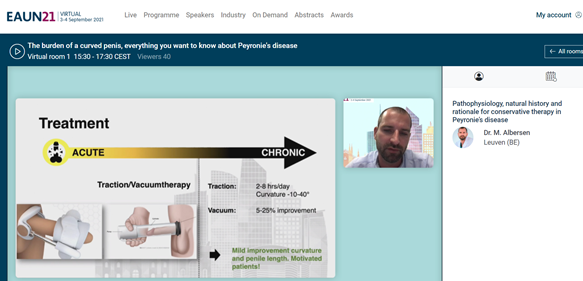EAUN21 delivers crucial insights on Peyronie’s disease
During the 21st International EAUN Meeting (EAUN21), the ESU Course “The burden of a curved penis, everything you want to know about Peyronie’s disease” took place on Friday, 3 September 2021. Chaired by Dr. Maarten Albersen (BE), the course proved to be full of information using a breadth of clinical expertise to summarise some of the challenges in treating patients with penile curvature.
The course defined Peyronie’s disease and its natural history. An understading of this clearly helps us counsel our patients, and encourages them to understand what is happening and why. The importance of managing patients in the active and stable phase was also discussed. The panel reiterated that there is no effective oral therapy for Peyronie’s disease, yet despite this well-known fact, patients are often prescribed oral agents. The panel acknowledged this was often more for psychological reasons.
A constant theme of the course was managing patient expectations throughout the process of seeing these patients. It is important to let them know they will, sadly, never have their “old penis back”. The aim of management is to have a patient who can successfully function. In my lecture “Diagnostic evaluation of the patient and partner”, I suggested that we should not be operating on patients who can successfully engage in intercourse. If, however, a patient or their partner cannot engage in sexual activity to their satisfaction, intervention should be considered in the stable phase of the disease.

The panel discussed the stepwise ladder-like treatment for erectile dysfunction and were keen to reiterate how integral this is to the management. A patient with a straight penis and poor erections is often no better than a patient with a substantial curvature and strong erections. It is crucial to understand which aspect is causing the patient most concern, if not both.
Non-surgical treatment strategies include painkillers, vacuum/traction devices, and injection therapy. Painkillers are useful particularly in the active phase of the disease. Injection therapy and surgery should be reserved for the stable phase. Surgical treatment was outlined broadly into plication, grafting, and penile implant surgery. Once again the panel discussed the importance of careful counselling of these patients which starts at the assessment stage with a thorough history, examination, and of course, digital pictures of the curvature.
Overall, the course provided a succinct and comprehensive overview of penile curvature and its management.
By Mr. Vaibhav Modgil, BM, MSc, FRCS, Manchester (UK)

